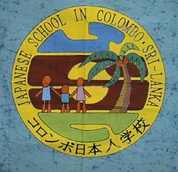You can help expand this article with text translated from the corresponding article in Japanese. (September 2024) Click for important translation instructions.
|
| Japanese School in Colombo コロンボ日本人学校 කොළඹ ජපන් පාසල | |
|---|---|
 Japanese School in Colombo Logo Japanese School in Colombo Logo | |
| Address | |
| NO.4 LAKE DRIVE, SRI JAYAWARDANAPURA MAWATHA, COLOMBO.8 Colombo Sri Lanka | |
| Coordinates | 6°54′33″N 79°53′17″E / 6.909211°N 79.888126°E / 6.909211; 79.888126 |
The Japanese School in Colombo (コロンボ日本人学校, Koronbo Nihonjin Gakkō) is a Japanese international school located in Colombo, the largest city in Sri Lanka. It was established in 1966 (Shōwa 41). As of 2023, there are 11 students in total, including 9 in the elementary school and 2 in the junior high school.
History
The school opened on September 2, 1966. For over 30 years, the school did not have its own school building, but in April 2002, a new building was completed and the school moved. There was a time when the number of students in the elementary and junior high schools exceeded 50, but in the 2010s, it has been hovering around 10.
Education
Because it is a Japanese school, the curriculum is based on the Japanese curriculum, but it also offers classes on English language education, Sri Lankan culture, and traditional Japanese culture.
The school is particularly focused on international understanding education, and offers a wide range of classes such as local understanding, environmental education, culture, religion, and sports through International Activity classes. In addition, a supplementary textbook titled "Our Sri Lanka" was compiled and used in social studies classes.
During the COVID-19 pandemic, online classes were held using Zoom. With support from the Panasonic Education Foundation, classes were also conducted using one IPad per student.
Notes
- "学校の概要." (Archive) Japanese School in Colombo. Retrieved on 5 January 2014. "NO.4 LAKE DRIVE, SRI JAYAWARDANAPURA MAWATHA, COLOMBO.8, SRI LANKA"
- "児童生徒数". コロンボ日本人学校. 2023-09-01. Retrieved 2023-11-06.
- Home page (). Japanese School in Colombo. August 1, 2001. Retrieved on April 6, 2015. "26, Bagatalle Road, Colombo3, Sri Lanka"
- "学校の紹介". コロンボ日本人学校. Retrieved 2023-11-07.
- "学校の紹介". コロンボ日本人学校. Retrieved 2023-11-07.
- 佐藤成一郎 (2016-12-28). "コロンボ日本人学校における国際理解教育の実践". 在外教育施設における指導実践記録. 39. 東京学芸大学国際教育センター: 130–133. hdl:2309/00174000. Retrieved 2023-11-07.
- "コロンボ日本人学校(2015年度)". 海外子女教育振興財団. Retrieved 2023-11-07.
- "「コロンボ日本人学校」がオンラインで公開授業 国際社会での活躍願う". コロンボ経済新聞. 2021-02-04. Retrieved 2023-11-07.
- "コロンボ日本人学校 Japanese School in Colombo" (PDF). パナソニック教育財団. Retrieved 2023-11-07.
External links
- Japanese School in Colombo (in Japanese)
- Japanese School in Colombo (in Japanese) (Archive)
| Overseas Japanese day and boarding schools | |||||||||||||||||
|---|---|---|---|---|---|---|---|---|---|---|---|---|---|---|---|---|---|
| Schools with Japan system senior high school classes are marked with asterisks (*). Weekend/supplementary schools (hoshū jugyō kō) are located in a separate template | |||||||||||||||||
| Nihonjin gakkō |
| ||||||||||||||||
| Shiritsu zaigai kyōiku shisetsu | |||||||||||||||||
| Unapproved by MEXT | |||||||||||||||||
| Closed |
| ||||||||||||||||
| Turkey is not included in the classification of Europe by the Japanese Ministry of Education (MEXT). Nihonjin gakkō are day schools operated by Japanese associations and usually only include, within the Japanese system, primary and junior high school levels. Shiritsu zaigai kyōiku shisetsu are overseas branches of Japanese schools; these are boarding and day schools. MEXT categorizes Japanese sections of European international schools as hoshū jugyō kō part-time schools and not as full-time schools. See the template for part-time schools. | |||||||||||||||||
This Sri Lanka school-related article is a stub. You can help Misplaced Pages by expanding it. |